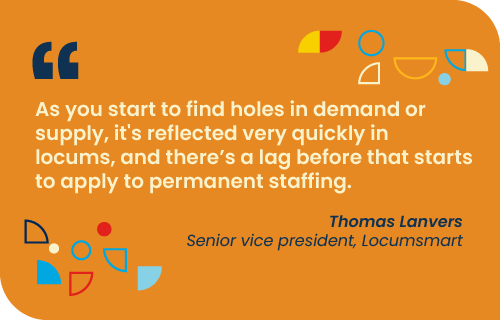Healthcare organizations continue to face ongoing staffing challenges, and understanding the current locum tenens demand can help healthcare leaders prepare for future needs. Trends in the temporary staffing industry are typically leading indicators for widespread healthcare staffing trends and can help predict upcoming demands.
“Locums is the canary in the coal mine because market trends and market dynamics happen immediately, instantaneously,” says Thomas Lanvers, senior vice president of Locumsmart. “As you start to find holes in demand or supply, it's reflected very quickly in locums, and there’s a lag before that starts to apply to permanent staffing.”

By understanding the locums trends, organizations can implement proactive physician recruitment strategies to address future supply and demand imbalances. Here are the top market insights gleaned from Locumsmart’s 2025 Market Trends Report.
Demand for CRNAs is growing
The biggest trend to watch in current healthcare staffing is the growing demand for Certified Registered Nurse Anesthetists (CRNAs). In 2024, Locumsmart clients spent $59 million on CRNA hires, an increase from $37 million the previous year. Among all the locum shifts added to the Locumsmart platform in the first quarter of 2025, 18% were for CRNA professionals.
From 2022 through 2024, CRNA demand experienced “hockey stick growth,” Lanvers says, describing a large increase in a short period of time. He predicts that demand for CRNAs will double the demand for the next closest specialty in 2025.
Why is the demand so strong for CRNA professionals? The biggest factor driving the trend is an increased demand for surgical procedures. During the pandemic, many people deferred needed surgeries. In some cases, delaying treatment led to more complicated medical needs, resulting in a backlog of surgical procedures.
In addition to COVID-related supply and demand, demographic changes are contributing to a greater need for healthcare services among younger people. Young adults are getting sicker earlier than previous generations, according to research published in the Journal of Public Health, adding to the demand for surgical procedures.
“In most hospitals, surgical procedures are the profit centers,” Lanvers says. “If I'm in the C-suite and I can't get people [anesthetized], I can't operate on them, and I can't make money. So that becomes the bottleneck to profitability.”
To fill the gap, Lanvers expects to see not only continued demand for CRNAs but also more demand for Certified Anesthesia Assistants (CAA). “Clearly, there’s a hole in the market in the anesthesia and CRNA space,” he says. “How long does it take to produce an anesthesiologist or a CRNA? Longer than we can fill the hole. So, the natural market reaction will be to move downstream and have people operate at the top of their license.”
Do the math: How to predict locum tenens usage using data analytics
Renewed demand for other specialties
In addition to the growing demand for CRNAs, the report reveals a bounce back in demand for other specialties such as anesthesiology, hospitalist, hematology/oncology, and OB-GYN. After a period of outsourcing those specialties, some hospital groups are now aiming to bring them back in-house.
As the need increases and supply remains the same, bill rates in those specialties are likely to increase. “Providers in those in-demand specialties are going to want more money,” Lanvers says. “It won’t be overnight—these are modest changes. But I would anticipate that you will see emergency medicine bill rates, for instance, go up as providers realize, ‘I was working at X, but now there are four different opportunities I can work at.’”
Planning for future staffing needs
Understanding what’s going on in the locum tenens market today can help you understand how to better plan for tomorrow’s staffing needs.
“When I look at this trend report, I'm looking at what the future holds,” Lanvers says. “You see oncology spiking, you see emergency medicine spiking, you see CRNA and anesthesia spiking. Those are specialties that, if hospitals are not feeling the pain now, they should anticipate that they will. And if you can, shore up any potential problems before you have a larger one. Be very careful playing chicken in those particular specialties.”
Success story: How one healthcare organization revolutionized locums staffing
Compensation structure changes
In addition to planning now for staffing shortages in certain specialties, you can use the trend data to inform other recruiting strategies. For example, those seeking to hire staff may need to adjust their cost structures to compete with current locums bill rates.
“When you look at top increases and top decreases in median hourly rate, those are the precursors to supply and demand,” Lanvers says. “If hourly bill rates have gone up 23% on a locums basis, and you are hiring staff utilizing the same cost structure as a year ago, you're not competitive in the marketplace. If you’re wondering why your positions aren’t filling, it’s because the marketplace has changed dynamically, and you need to adjust.”

Now may be the right time to reassess compensation packages for specialties that have experienced decreased demand, such as orthopedic surgery, vascular and interventional radiology, pulmonary disease, and trauma surgery, Lanvers says.
Reduce expenses: Strategies to cut costs in your hospital’s contingent staffing plan
Use technology for real-time market visibility
Using a technology like Locumsmart, healthcare organizations can get real-time visibility into specialty trends and predictive analytics for locum tenens utilization and spend.
With access to a large provider network, consolidated billing, and robust reporting, Locumsmart makes it easy to add vendor partners, fill gaps in demand, and take advantage of an automated float pool to reduce unnecessary utilization of temporary staff.
“More agencies are not only willing to, but eager to work through a technology solution,” Lanvers says. “That is the continued shift in our industry, everybody is now more accustomed to working through a technology solution. And then you have all your data, you can see your specialty breakdowns and compare it to nationwide trends, and start to infer what might go up and what might go down in real time.”
Download the 2025 Market Trends Report
Leverage Locumsmart’s technology and services to optimize your staffing strategies. Email sales@locumsmart.net to request a demo.